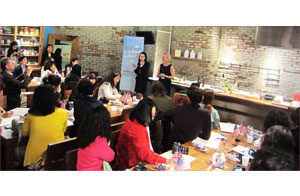Saunders explained for the consumer group that she grew up on a ranch where her father and grandfather still work.
She spoke on behalf of the U.S. beef industry and discussed the commitment her family shares with other ranchers to do their best to protect natural resources and produce high quality, safe beef.
"It was fascinating meeting with Korean consumers and these trusted bloggers,” said Saunders.
“It is very obvious that while we speak different languages and come from different cultures, we all want the same thing when it comes to our food choices and feeding our families. We all want safe, healthy, cost-effective alternatives.
Consumers worldwide want transparency, authenticity and more information about the families behind their food."
The U.S. pork industry was represented by Becca Hendricks, National Pork Board assistant vice president of international marketing, who explained the industry’s “We Care” program, which demonstrates producers’ commitment to raise pork responsibly.
She also reviewed innovations the industry has introduced over the past 50 years to produce safe, affordable, versatile, nutritious and tasty pork.
“Events like this help garner consumer interest and respect for U.S. pork,” said Hendricks.
“In South Korea, consumers tend to trust their peers on issues of health and nutrition, so our presentations and the chef demonstrations were well-received.
The U.S. pork industry’s efforts are moving more towards influencing consumers directly. It helps gain trust in our product as well as allowing consumers to taste a great recipe.”
USMEF President and CEO Philip Seng introduced the program, which included two celebrity chefs, Chef Lee Sang-hak and Chef Shin Hyo-seob, who are very popular with Korean consumers.
Their cooking demonstration gave the participants a sampling of U.S. beef chuck eye roll skewers with black olive Chimichurri sauce and U.S. pulled pork sandwich.
Representing the luxurious Westin Chosun hotel in Seoul, Chef Lee praised the quality of U.S. beef while Chef Shin, who is part of a U.S. pork radio advertising campaign, stressed the good taste and quality of American pork.
“It is more credible to hear from the people from the U.S. how cattle and hogs are raised and beef and pork are produced,” said one consumer.
“The U.S. meat stories from the homemakers from the U.S. have touched my heart,” said one blogger.
“It was a great time. I always have a good time when I participate in USMEF’s activities because you can get valuable information as well as you can taste delicious meat.”
One blogger, whose writings are viewed by nearly 2,000 Korean consumers daily, posted this.
Funding for the seminar was provided through the USDA Market Access Program (MAP) as well as the Beef Checkoff and Pork Checkoff programs.
In 2011, South Korea was a leading market for both U.S. beef and pork exports, buying 154,019 metric tons (339.6 million pounds) of beef valued at $686 million, and 188,307 metric tons (415.1 million pounds) of pork valued at $497.1 million.
The recent implementation of the Korea-U.S. Free Trade Agreement is expected to enhance export opportunities for both in the coming years. ![]()
—From U.S. Meat Export Federation news release
PHOTO
Leann Saunders addresses Korean consumers and bloggers. Photo courtesy of U.S. Meat Export Federation.








